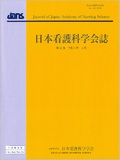Japanese
English
- 販売していません
- Abstract 文献概要
- 参考文献 Reference
要旨
目的:我が国の思春期における自己受容の概念の構造と機能を明らかにし,その受容過程および周囲の関わり方を検討することである.
方法:分析方法は,Walker & Avantの手法を用いた.辞書,書籍等に掲載されている定義,類似概念との相違を検討後,対象文献より属性,先行要件,帰結を抽出した.
結果:属性は4項目,先行要件は他者からの関わりと自己の内面への意識的な働きかけを含む8項目,帰結は5項目が抽出された.
結論:我が国の思春期における自己受容の概念は,「他者からの関わりや自己の内面への働きかけを受けて,自己を理解し信頼することであり,自己を寛容に受け止め,自己の課題に折り合いをつけることで,他者との関係性や自己の状態の充実がもたらされる状態」であると定義された.また,思春期の自己受容を促していくためには,それぞれの役割や立場に応じた周囲の関わりや発達課題に着目した介入が重要であることが示唆された.
Objective: The study aimed to clarify the structure and function of the concept of self-acceptance in Japanese adolescents and examine the acceptance process and modes of interaction with those around them.
Methods: The analysis was performed using Walker & Avant's concept analysis method. After examining the differences in definitions and similar concepts published in dictionaries and books, attributes, antecedent requirements, and consequences were extracted from the target literature.
Results: Four items of attributes, eight items of antecedent requirements, including involvement with others and conscious work on one's inner self, and five items of consequences were extracted.
Conclusion: The concept of self-acceptance in Japanese adolescents is defined as “the state of understanding and trusting oneself in response to involvement with others and conscious work on one's inner self. By accepting oneself tolerantly and reconciling one's challenges, fulfillment is brought about in the relationship with others and one's condition.” To promote self-acceptance in adolescents, it is important to focus on the developmental issues and relationships of the people around them according to their roles and positions.
Copyright © 2021, Japan Academy of Nursing Science. All rights reserved.


